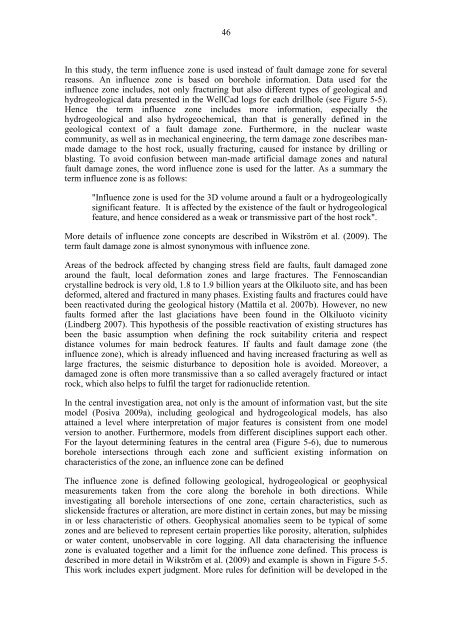RSC-Programme - Interim Report. Approach and Basis for - Posiva
RSC-Programme - Interim Report. Approach and Basis for - Posiva
RSC-Programme - Interim Report. Approach and Basis for - Posiva
Create successful ePaper yourself
Turn your PDF publications into a flip-book with our unique Google optimized e-Paper software.
46In this study, the term influence zone is used instead of fault damage zone <strong>for</strong> severalreasons. An influence zone is based on borehole in<strong>for</strong>mation. Data used <strong>for</strong> theinfluence zone includes, not only fracturing but also different types of geological <strong>and</strong>hydrogeological data presented in the WellCad logs <strong>for</strong> each drillhole (see Figure 5-5).Hence the term influence zone includes more in<strong>for</strong>mation, especially thehydrogeological <strong>and</strong> also hydrogeochemical, than that is generally defined in thegeological context of a fault damage zone. Furthermore, in the nuclear wastecommunity, as well as in mechanical engineering, the term damage zone describes manmadedamage to the host rock, usually fracturing, caused <strong>for</strong> instance by drilling orblasting. To avoid confusion between man-made artificial damage zones <strong>and</strong> naturalfault damage zones, the word influence zone is used <strong>for</strong> the latter. As a summary theterm influence zone is as follows:"Influence zone is used <strong>for</strong> the 3D volume around a fault or a hydrogeologicallysignificant feature. It is affected by the existence of the fault or hydrogeologicalfeature, <strong>and</strong> hence considered as a weak or transmissive part of the host rock".More details of influence zone concepts are described in Wikström et al. (2009). Theterm fault damage zone is almost synonymous with influence zone.Areas of the bedrock affected by changing stress field are faults, fault damaged zonearound the fault, local de<strong>for</strong>mation zones <strong>and</strong> large fractures. The Fennosc<strong>and</strong>iancrystalline bedrock is very old, 1.8 to 1.9 billion years at the Olkiluoto site, <strong>and</strong> has beende<strong>for</strong>med, altered <strong>and</strong> fractured in many phases. Existing faults <strong>and</strong> fractures could havebeen reactivated during the geological history (Mattila et al. 2007b). However, no newfaults <strong>for</strong>med after the last glaciations have been found in the Olkiluoto vicinity(Lindberg 2007). This hypothesis of the possible reactivation of existing structures hasbeen the basic assumption when defining the rock suitability criteria <strong>and</strong> respectdistance volumes <strong>for</strong> main bedrock features. If faults <strong>and</strong> fault damage zone (theinfluence zone), which is already influenced <strong>and</strong> having increased fracturing as well aslarge fractures, the seismic disturbance to deposition hole is avoided. Moreover, adamaged zone is often more transmissive than a so called averagely fractured or intactrock, which also helps to fulfil the target <strong>for</strong> radionuclide retention.In the central investigation area, not only is the amount of in<strong>for</strong>mation vast, but the sitemodel (<strong>Posiva</strong> 2009a), including geological <strong>and</strong> hydrogeological models, has alsoattained a level where interpretation of major features is consistent from one modelversion to another. Furthermore, models from different disciplines support each other.For the layout determining features in the central area (Figure 5-6), due to numerousborehole intersections through each zone <strong>and</strong> sufficient existing in<strong>for</strong>mation oncharacteristics of the zone, an influence zone can be definedThe influence zone is defined following geological, hydrogeological or geophysicalmeasurements taken from the core along the borehole in both directions. Whileinvestigating all borehole intersections of one zone, certain characteristics, such asslickenside fractures or alteration, are more distinct in certain zones, but may be missingin or less characteristic of others. Geophysical anomalies seem to be typical of somezones <strong>and</strong> are believed to represent certain properties like porosity, alteration, sulphidesor water content, unobservable in core logging. All data characterising the influencezone is evaluated together <strong>and</strong> a limit <strong>for</strong> the influence zone defined. This process isdescribed in more detail in Wikström et al. (2009) <strong>and</strong> example is shown in Figure 5-5.This work includes expert judgment. More rules <strong>for</strong> definition will be developed in the
















